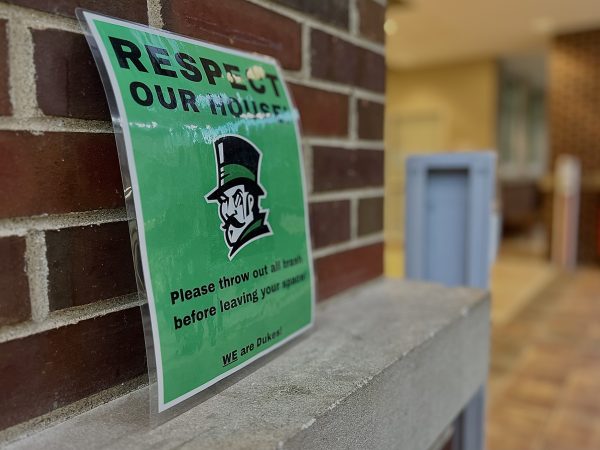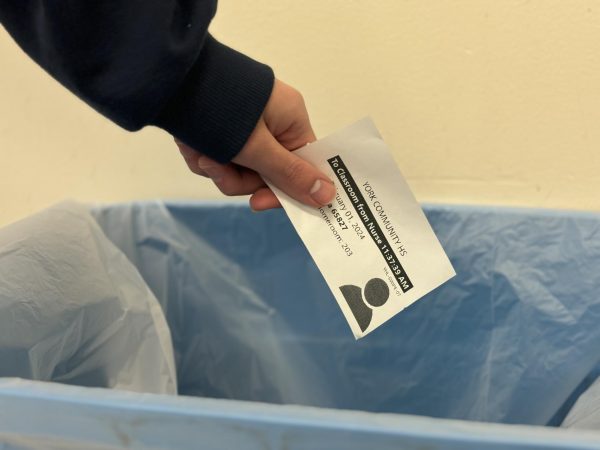York institutes use of Polar Heart Rate Monitors in P.E. classes
A Polar Heart Rate Monitor used by York P.E. classes during fitness days.
This school year, the York P.E. department has instituted the use of Polar Heart Rate Monitors in all P.E. classes, with Junior/Senior electives using them once per week and P.E. 9/P.E. 10 using them twice per week. The Heart Monitors are part of a broader strategic plan proposed by the State of Illinois in an effort to create curriculum changes in P.E. departments that lead to students engaging in moderate to vigorous physical activity for longer periods of time. Dubbed Enhanced Physical Education, this plan strives to ensure that all K-12 students have access to high quality instruction in physical fitness.
National research has revealed that time spent by children exercising is consistently low. Studies estimate that in a typical half hour P.E. class, children are involved in approximately eleven minutes of physical activity (Illinois Enhanced Physical Education Strategic Plan). In perspective, this means that less than 37% of P.E. class time is dedicated to exercise.
In response to this crisis, the Illinois State Board of Education and Illinois Department of Public Health rallied together to create a plan which would combat this statistic.
“A plan [which] provides a high-level roadmap for implementing a vision that all students enrolled in Illinois K-12 schools will participate in daily, high-quality physical education,” said the State of Illinois’ Enhanced P.E. Task Force.
Illinois, a pioneer in physical education initiatives for the K-12 school system, was the first state in the United States to require daily P.E. for all students. Today, Health Standard No. 20 is in effect and is described as an “outline for achieving and maintaining a health-enhancing level of physical fitness based upon continual self-assessment” by the State of Illinois.
The “self-assessment” portion of this vision has been enacted at York with the introduction of the Heart Rate Monitors.
“Students can access data [from their cardiovascular workouts] online if given a password, ”said Lauren DeAngelis, the Physical Education, Health, and Driver Education Department Chair. “However, PE teachers can [also] provide students a screenshot or printout of their individualized workout in a graph form with a breakdown of their time vs. heart rate.”
In fact, the State of Illinois initiatives align with the recommendations from the Center for Disease Control and Prevention’s Guide to Community Preventive Services which strives to improve the health of America’s communities.
What is more, numerous research studies conducted by the Illinois Public Health Institute and organizations such as Action for Healthy Kids and GENYouth have concluded that physical activity reaps numerous benefits.
“Physical education… not only correlates directly to the lifelong health and well-being of students, [but] has cognitive benefits, too, making students more receptive to learning,” said the State of Illinois’ Enhanced P.E. Task Force.
“There is a significant body of research showing that children who are more physically active perform better in class and on standardized tests,” said the State of Illinois’ Enhanced P.E. Task Force. “Improving opportunities for physical activity is imperative for improving our children’s academic achievement and their health.”
Obstacles encountered with Polar Heart Rate Monitors
Although it is evident that Illinois’ health initiatives and corresponding Polar Heart Rate Monitors provide an array of physical and cognitive benefits, they have created obstacles for students and teachers alike.
“With any new technology device [the Polar Heart Rate Monitors] and program there are always a few kinks to work out,” said DeAngelis. “Some of the challenges have been school internet connections, lack of LCD projectors and monitors in the P.E. facilities to view the student data, limited app licences, and having students bring their heart rate straps to P.E. class.”
Besides creating technical difficulties, the Polar Heart Rate Monitors have also proven to be frustrating for students.
“I’ve been frustrated with the heart rate monitors because instead of focusing on the exercise, I’m focusing on getting them to work and this detracts from the quality of the exercises,” said junior Janae Nutter.
A dance instructor at York also voiced a concern echoed by students in her Dance Fitness class.
“Unfortunately, the heart straps do not always work properly and therefore students fidget and worry about the Heart Rate Monitor straps rather than focus on the movements and directions of the teacher,” said Anna Sapozhnikov, a dance instructor at York.
Aside from these concerns, teachers and students, alike, admit that the Polar Heart Rate Monitors make them more conscious of the effort they are exerting towards achieving physical fitness.
“The Polar Heart Monitors are a great motivational tool for us to really exercise in Dance Fitness,” said Sapozhnikov.
“Although the Polar Heart Rate Monitors are sometimes frustrating because if you are more physically fit it is harder to get your heart rate into the target heart rate zone, I have noticed that whenever we use them I see everyone working hard and it’s a blast,” said junior Emily Landreth.
Given that the United States has such a strong consumer culture, it is becoming imperative to be cognizant of one’s physical fitness so as to avoid diseases such as diabetes and heart disease which are among the leading causes of mortality in the U.S.
“As a P.E. staff, we want to develop individuals who are committed to lifelong fitness and have the knowledge when leaving York to live healthy lifestyles,” said DeAngelis.

Laura Swain, senior at York, is a Co-Editor in Chief for York-hi. She has been a dancer for 10 years and teaches ballet at the Elmhurst Park District....












